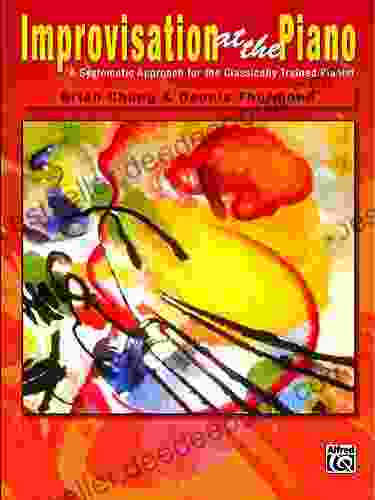A Systematic Approach for the Classically Trained Pianist: Unlocking the Secrets of Virtuosity

For the aspiring classical pianist, the pursuit of excellence demands a systematic and dedicated approach. This article provides a comprehensive guide to a holistic methodology for unlocking the true potential of the classically trained pianist. We will delve into essential aspects such as technique, musicianship, practice strategies, repertoire selection, and performance techniques, laying the groundwork for a journey towards virtuosity.
4.2 out of 5
| Language | : | English |
| File size | : | 22962 KB |
| Screen Reader | : | Supported |
| Print length | : | 232 pages |
1. Technique
At the core of piano playing lies the mastery of technique. Embarking on a systematic approach involves breaking down complex technical concepts into manageable components. This includes:
- Finger exercises: Essential for developing flexibility, dexterity, and independence of the fingers.
- Scales and arpeggios: Provide a foundation for finger coordination, evenness, and fluency.
- Technical studies: Designed to address specific technical challenges such as trills, tremolos, and octaves.
- Sight-reading: Enhances the ability to interpret and execute new music at first sight, improving overall musicianship.
2. Musicianship
True musicality extends beyond technical proficiency. Musicianship encompasses the ability to interpret and convey the essence of the music. This involves:
- Theory and analysis: Understanding the underlying structure and principles of music, including harmony, melody, and rhythm.
- Ear training: Developing the ability to recognize and reproduce musical intervals, chords, and rhythms.
- History and performance practice: Gaining insights into the historical context and performance practices of different musical eras.
- Chamber music and ensemble playing: Collaborating with other musicians to develop listening skills, ensemble sensitivity, and musical interpretation.
3. Practice Strategies
Effective practice is crucial for pianists to refine their skills and achieve their musical goals. A systematic approach involves:
- Structured practice sessions: Planning and organizing practice time into focused segments dedicated to specific technical or musical aspects.
- Consistent daily practice: Establishing a regular and consistent practice schedule to maintain progress and develop muscle memory.
- Mindful practice: Paying attention to details, isolating problem areas, and actively working to improve them.
- Goal-setting: Establishing specific, achievable goals for each practice session and long-term progress.
4. Repertoire Selection
The choice of repertoire plays a significant role in the development of a pianist's technique and musicianship. A systematic approach involves:
- Gradual progression: Starting with repertoire that is within reach and gradually increasing the difficulty as skills develop.
- Diversity: Exploring different styles, periods, and composers to expand musical horizons and develop versatility.
- Balance: Including pieces that focus on technical development, musical interpretation, and performance skills.
- Consultation with a teacher: Seeking guidance from an experienced piano teacher to make informed repertoire choices tailored to individual needs.
5. Performance Techniques
Mastering performance techniques elevates the pianist's ability to effectively convey the music to an audience. This involves:
- Stage presence: Developing confidence, poise, and stage etiquette.
- Memory skills: Training the memory to retain the music and perform without a score.
- Interpretation: Shaping the music through tempo, dynamics, and articulation to create a compelling narrative.
- Communication: Connecting with the audience and conveying the emotional depth of the music.
Embracing a systematic approach for the classically trained pianist provides a roadmap towards achieving musical excellence. By integrating the essential elements of technique, musicianship, practice strategies, repertoire selection, and performance techniques, pianists can unlock their true potential and embark on a journey of musical discovery and virtuosity. Regular practice, dedication, and the guidance of an experienced teacher are the keys to unlocking the secrets of the piano and leaving an unforgettable mark on the world of music.
4.2 out of 5
| Language | : | English |
| File size | : | 22962 KB |
| Screen Reader | : | Supported |
| Print length | : | 232 pages |
Do you want to contribute by writing guest posts on this blog?
Please contact us and send us a resume of previous articles that you have written.
 Novel
Novel Text
Text Story
Story Genre
Genre Paperback
Paperback E-book
E-book Magazine
Magazine Newspaper
Newspaper Paragraph
Paragraph Bookmark
Bookmark Glossary
Glossary Annotation
Annotation Manuscript
Manuscript Scroll
Scroll Classics
Classics Library card
Library card Narrative
Narrative Biography
Biography Autobiography
Autobiography Memoir
Memoir Reference
Reference Thesaurus
Thesaurus Character
Character Resolution
Resolution Borrowing
Borrowing Archives
Archives Periodicals
Periodicals Study
Study Scholarly
Scholarly Reserve
Reserve Academic
Academic Journals
Journals Reading Room
Reading Room Rare Books
Rare Books Literacy
Literacy Dissertation
Dissertation Storytelling
Storytelling Awards
Awards Theory
Theory Textbooks
Textbooks Lilah Rivers
Lilah Rivers William Wegman
William Wegman Eitan Shamir
Eitan Shamir Eric A Posner
Eric A Posner R B Bernstein
R B Bernstein Norman K Risjord
Norman K Risjord Jonathan Safran Foer
Jonathan Safran Foer Russ Veillard
Russ Veillard Milton P Dentch
Milton P Dentch Bill Strom
Bill Strom William Jeffrey
William Jeffrey Michael Krugman
Michael Krugman Dmitry Orlov
Dmitry Orlov George Kitchin
George Kitchin Bobby Britnell
Bobby Britnell Colette Makray
Colette Makray Geoff Harkness
Geoff Harkness David Rosenmann Taub
David Rosenmann Taub Christopher Castellani
Christopher Castellani Pete Ford
Pete Ford
Light bulbAdvertise smarter! Our strategic ad space ensures maximum exposure. Reserve your spot today!

 Jonathan HayesThe Black Corleones: Love Ain't Loyal - A Gripping Tale of Crime, Power, and...
Jonathan HayesThe Black Corleones: Love Ain't Loyal - A Gripping Tale of Crime, Power, and... Jared NelsonFollow ·8.2k
Jared NelsonFollow ·8.2k Gene SimmonsFollow ·13k
Gene SimmonsFollow ·13k Ike BellFollow ·17.2k
Ike BellFollow ·17.2k Hugo CoxFollow ·19.2k
Hugo CoxFollow ·19.2k Tyler NelsonFollow ·12.3k
Tyler NelsonFollow ·12.3k Jedidiah HayesFollow ·16.4k
Jedidiah HayesFollow ·16.4k Houston PowellFollow ·7.2k
Houston PowellFollow ·7.2k Nick TurnerFollow ·17.2k
Nick TurnerFollow ·17.2k

 Brian Bell
Brian BellClassic Festival Solos Bassoon Volume Piano...
The Classic Festival Solos Bassoon Volume...

 Aubrey Blair
Aubrey BlairUnveiling the Courage: Insurgent Women Female Combatants...
In the face of armed...

 Jan Mitchell
Jan MitchellFor The Liberty Of Texas: The Lone Star State's Fight for...
The Republic of Texas was a sovereign state...

 Edgar Allan Poe
Edgar Allan PoeVisible, Explainable, Trustworthy, and Transparent...
What is VET2...
4.2 out of 5
| Language | : | English |
| File size | : | 22962 KB |
| Screen Reader | : | Supported |
| Print length | : | 232 pages |














